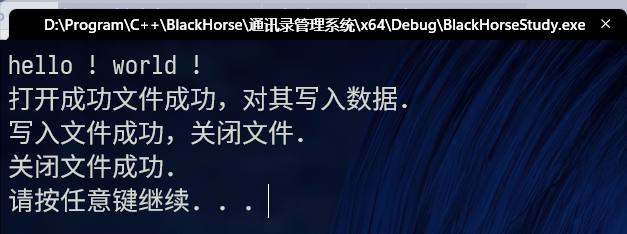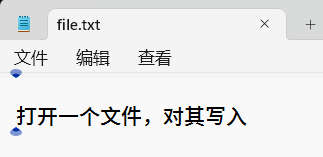以下内容仅为当前认识,可能有不足之处,欢迎讨论!
文件操作
文件写入流程
写文件包括以下几个步骤
1.包含头文件
2.创建流对象
3.打开文件,以指定方式
4.写入内容
5.关闭文件
1.头文件一般用
ofstream(写文件) ——从编译器中向文件写,故为output-file-stream,
ifstream(读文件)——从文件中向编译器读,故为in-file-stream,
fstream(读写文件)——从文件中可以读出数据,也可以将编译器中的数据写入文件,故为file-stream。
流对象一般用对应头文件的对象。
指定方式有表格,可以指定多种,用|来分割。
| 模式标志 | 描述 |
|---|---|
| ios::app | 追加模式。所有写入都追加到文件末尾 |
| ios::ate | 文件打开后定位到文件末尾 |
| ios::in | 打开文件用于读取 |
| ios::out | 打开文件用于写入 |
| io::trunc | 如果该文件已经存在,内容将在打开文件之前被截断,即把文件长度设置为0 |
写入内容是左移运算符
关闭文件一般是close()函数
简单的demo写操作
代码
#include<iostream>
using namespace std;
#include<string>
#include<fstream>
void test0226_0() {
/*
写文件包括以下几个步骤
1.包含头文件
2.创建流对象
3.打开文件,以指定方式
4.写入内容
5.关闭文件
头文件一般用ofstream , ifstream , fstream
流对象一般用对应头文件的对象
指定方式有表格,可以指定多种,用|来分割
写入内容是左移运算符
关闭文件一般是close()函数
*/
//1.创建流对象
fstream fs;
//2.打开文件及指定打开方式
fs.open("file.txt", ios::app);
cout << "打开成功文件成功,对其写入数据." << endl;
fs << "打开一个文件,对其写入" << endl;
cout << "写入文件成功,关闭文件." << endl;
fs.close();
cout << "关闭文件成功." << endl;
}
int main() {
cout << "hello ! world ! " << endl;
test0226_0();
system("pause");
return 0;}
运行结果:


可以看到成功写入。
文件读流程
文件读流程有4种方式。
①通过右移运算符放入字符数组中;
ifstream ifs;
ifs.open("file.txt",ios::in);
if (!ifs.is_open()){
return;
}
char char_arry[1024]={0};
while (ifs>>char_array){
cout<<char_array<<endl;
}
ifs.close();
②通过文件流对象自带的getline函数用字符数组逐行接收;
ifstream ifs;
ifs.open("file.txt",ios::in);
if(!ifs.is_open()){
return ;
}
char char_array[1024]={0};
while (ifs.getline(char_array,sizeof(char_array))){
cout<<char_array<<endl;
}
ifs.close();
③通过string头文件自带的全局getline函数用string函数接收;
ifstream ifs;
ifs.open("file.txt" , ios::in);
if(!ifs.is_open()){
return ;
}
string array;
while(getline(ifs , array)){
cout<<array<<endl;
}
ifs.close();
④通过文件流对象逐个读取字符打印。
ifstream ifs;
ifs.open("file.txt" , ios::in);
if(!ifs.is_open()){
return ;
}
char c;
while(c=ifs.get() && ifs.get()!= EOF){
cout<<c<<endl;
}
ifs.close();
最后种方式我打印不出来。

二进制写文件
二进制方式对文件写入
函数原型:ostream & write(const char * buffer , int len);
参数解释:字符指针buffer指向内存中一段存储空间。len是读写的字节数。
二进制方式写文件主要利用流对象调用成员函数write。
在用二进制方式写文件时,不必拘泥于固有的数据类型,也可以写入自定义的数据类型,比如类。但对于字符串,最好还是用char来写,因为底层是用C实现的。
代码实现:
#include<iostream>
#include<fstream>
using namespace std;
class Person{
public:
char name[1024];
int age;
};
void test0226(){
//1.写入头文件
//2.定义文件流
fstream fs;
//3.打开文件
fs.open("Person.txt" , ios::out | ios::binary);
//这里可以直接写成,有对应的构造函数
//fstream fs("Person.txt" , ios::in | ios::binary);
//4.写入数据
Person person={"张三",20} ;
//person.name = "张三";//这里不对,不能这样写
//person.age = 20;
fs.write((const char *)&person , sizeof(person));
//这里必须用强制类型转换,为什么要用引用,因为要获取地址
fs.close();
}
可以看到确实有这个文件

二进制读文件
二进制方式读取文件,函数原型:istream read(char *buffer , int len);,参数解释:字符指针buffer指向内存中一段存储空间,len是读写的字节数。
代码:
#include<iostream>
#include<fstream>
using namespace std;
class Person{
public:
char name[64];
int age;
};
void test0226_3() {
ifstream inBuffer;
inBuffer.open("Person.txt", ios::in | ios::binary);
if (!inBuffer.is_open()) {
return;
}
Person person;
inBuffer.read((char*)&person, sizeof(person));
cout << "person.name = " << person.name << ",person.age = " << person.age << "." << endl;
inBuffer.close();
}
int main() {
cout << "hello ! world ! " << endl;
test0226_3();
system("pause");
return 0;
}
运行结果如下

以上是我的学习笔记,希望对你有所帮助!
如有不当之处欢迎指出!谢谢!























 1万+
1万+











 被折叠的 条评论
为什么被折叠?
被折叠的 条评论
为什么被折叠?










